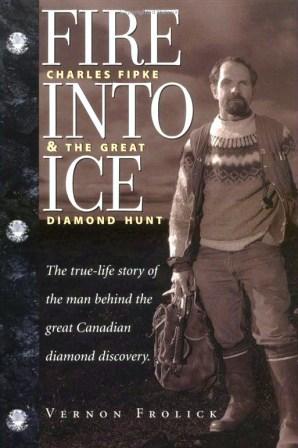
In 1969, while working in the Yukon, a geologist named Chuck Fipke needed to be rescued from a mountainside in the Mackenzie mountain range where he had been stranded for close to a week. Stewart Blusson, his boss at the time, sent in the helicopter that saved him. From then on, Fipke and Blusson became friends and prospecting partners. Between them, they changed the landscape of Canadian mining when they co-discovered the Ekati diamond mine in Canada’s arctic.
In 1981, Blusson and Fipke began searching for diamonds in the Northwest Territories, concentrating their search on indicator minerals commonly associated with kimberlite, a host rock for diamond. They found kimberlitic indicator minerals near Lac de Gras in the Northwest Territories in 1985, and their first kimberlite at Point Lake in 1991 which contained diamonds. Seven years later, in 1998, the Ekati mine opened as a joint venture between BHP Diamonds Inc. (51%), Dia Met Minerals (29%), Fipke (10%), and Blusson (10%) and the rest is, how shall we say, history. A book entitled, Fire and Ice, marks the story of Charles Fipke and the great Canadian diamond discovery.
Since 1998, the mine has produced over 50 million carats (8,888 kg / 19,595 lb) of diamonds out of six open pits. And as a result, Fipke and Blusson are now among Canada’s richest businessmen and both are active philanthropists. Stewart Blusson has earned the distinction as one of the most generous philanthropists in Canadian history with donations of more than $100 million to fund Canadian medical research and education.
In a telephone interview, MiningFeeds asked Stewart Blusson for his take on the diamond sector today – here’s what he had to say. “Most junior diamond exploration companies have stalled due to the success of other commodities. But what many people may not understand is diamond mining is so much more profitable than other mining. A rich diamond bearing pipe is the most valuable real estate on earth.” Mr. Blusson also pointed out, “Today the supply of diamonds is winding down because diamonds are not expandable like other commodities. They occur in the earth’s surface in one particular way and, by 2050, there may be nothing left to mine.”
1. Peregrine Diamonds Ltd. (TSX:PGD)
During the height of the financial crisis in November 2008, BHP Billiton elected to exercise its earn-in rights for the Chidliak diamond project. The price? $22.3-million in exploration over a two year period entitled the mining giant to a 51% interest in Peregrine Diamond’s biggest project. This marked a significant milestone in the company’s history and set the stage for a huge rally in the company’s share price from the $0.75 range to over $4.50. Since then, shares of Peregrine Diamonds have, over a three year period, trended back to the $1.00 mark.
Raymond Goldie, a senior mining analyst at Salman Partners, states in a report, “We note that BHP rarely enters into joint ventures with juniors, especially joint ventures in which the junior is, as is the case with Peregrine, the operator. BHP’s decision should not only increase the market’s confidence in the prospects of the Chidliak project, it should also increase the market’s confidence that the project can obtain financing through to production.”
A stable funding partner is a key part of the equation for a junior exploration and development diamond company since the average time frame from discovery to production is around 10 years and the costs are significant.
Is it time to revisit Peregrine Diamonds as an investor? We connected with Eric Friedland, younger brother to well-known mining venture capitalist Robert Friedland and CEO of Peregrine Diamonds, to find out what’s in store for the company – CLICK HERE – for the interview.

2. Stornoway Diamond Corp. (TSX:SWY)
A day late and a dollar short. Shareholders are hopeful the age-old idiom does not apply to Stornoway Diamond.
Stornoway’s flagship asset is the Renard Diamond Project which the company has been working on for 10 years in pursuit of becoming Québec’s first diamond mine. Current NI 43-101 compliant Indicated and Inferred Mineral Resources stand at 23.8 and 17.5 million carats respectively, with a further 23.5 to 48.5 million carats classified in the non-resource category. As Stornoway’s President & CEO, Matt Manson, pointed out during an interview with BNN on April, 2011, “Renard for us is the big value driver and big story.” During the interview, Mr. Manson also confirmed the Renard Feasibility Study was do for completion by the end of the third quarter, 2011 (September, 30th).
On September 20th, 2011, Stornoway reported their long awaited Renard Feasibility Study, which is to include an operating plan, mine plan, production schedule and cost estimates, was “nearing completion”. The company stated that, over the next several weeks, management would complete a final due diligence review in advance of its approval by the Board of Directors prior to its public release. That was seven weeks ago and still no word. And, based on some of the discussions taking place on internet message boards, investors are getting impatient. As one poster states, “Whats goin on here?…couldn’t imagine when (Stornoway) was 2.40 $ that it could go…to this level.” The company’s shares are currently trading at $1.49, down almost a $1.00 over the past four months.
With the company’s stock trading just above 52 week lows, there is another age-old idiom that shareholders of Stornoway Diamonds are very likely placing credence in – patience is a virtue.
For 5 Diamond Stocks to Watch – Part 2 – CLICK HERE.



 Follow us on Twitter
Follow us on Twitter Become our facebook fan
Become our facebook fan










Comments are closed.